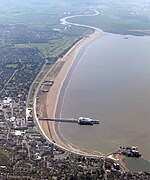Brean Down Fort

Brean Down Fort was a Victorian naval fortification designed to protect the Bristol Channel. It was built 60 feet (18 m) above sea level on the headland at Brean Down, 9 miles (14 km) south of Weston-super-Mare, Somerset, England. The site has a long history because of its prominent position. The earliest recorded settlement is from the Early to Middle Bronze Age. The current buildings were constructed in the 1860s as one of the Palmerston Forts to provide protection to the ports of the Bristol Channel, and was decommissioned in 1901. During World War II it was rearmed and used for experimental weapons testing. The site has been owned by the National Trust since 2002, following a £431,000 renovation project, as part of its Brean Down property and is open to the public. The fort was used as a location for filming of the second episode, "Warriors", of the BBC television drama Bonekickers. The fort was also used for exterior scenes of the Royal Marines attack on the villains base on Cragfest Island in episode six of 1978 HTV series The Doombolt Chase.
Excerpt from the Wikipedia article Brean Down Fort (License: CC BY-SA 3.0, Authors, Images).Brean Down Fort
Brean Down Road,
Geographical coordinates (GPS) Address Nearby Places Show on map
Geographical coordinates (GPS)
| Latitude | Longitude |
|---|---|
| N 51.327230555556 ° | E -3.0333555555556 ° |
Address
Brean Down Road
TA8 2RS , Brean
England, United Kingdom
Open on Google Maps











